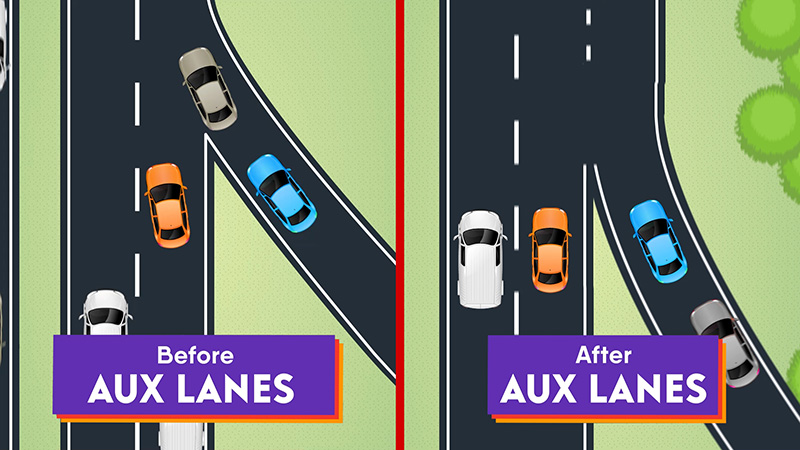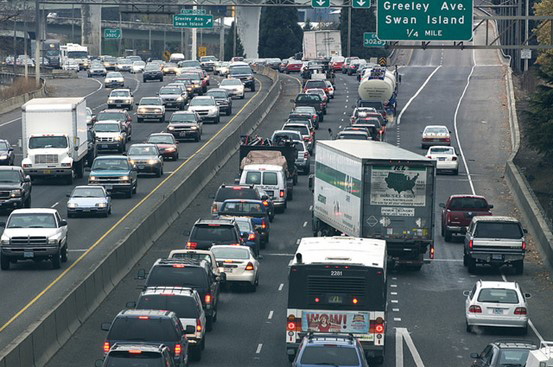About the Project
News
AUXILIARY LANES AND IMPROVED SHOULDERS ON I-5 IN THE ROSE QUARTER AREA RECEIVE STRONG SUPPORT IN NEW PUBLIC OPINION RESEARCH
Portland metro area residents want to see fixes to the I-5 Rose Quarter bottleneck, and adding ramp-to-ramp auxiliary lanes is at the top of their list. Key features of the planned highway improvements are new auxiliary lanes and standard-sized shoulders that will connect highway ramps within the Rose Quarter area to reduce congestion and increase safety. A recent survey of tri-county area residents held in June shows strong community support for major design elements found in the I-5 Rose Quarter Improvement Project, including auxiliary lanes, improved shoulders, paths and local street improvements and a cover over the highway to reconnect portions of the historic Albina neighborhood. So, what is so great about auxiliary lanes and improved shoulders?
BENEFITS OF AUXILIARY LANES AND IMPROVED SHOULDERS
Auxiliary lanes are ramp-to-ramp connections on the highway that reduce congestion by giving drivers more space and time to merge safely. They are a common and growing solution to congested highway bottlenecks throughout the United States where expensive, larger-scale highway widenings aren't practical.
There are several examples right here in Portland where auxiliary lanes have greatly reduced congestion and travel times for drivers while increasing safety. The new 1-mile-long I-205 northbound auxiliary lane connecting I-84 eastbound and NE Killingsworth Street improved an 11-mile stretch of congested I-205, reducing travel delays by more than four hours each day. The southbound auxiliary lane on I-5 connecting SW Lower Boones Ferry Road to I-205 led to a 29% decrease in crashes in one year and cut 90 minutes of daily congestion.
Watch a short two-minute video showing how auxiliary lanes work to reduce congestion.


Improved shoulders provide the needed space for disabled vehicles to move out of the way of traffic and for first responders to reach incidents more quickly. Some I-5 shoulder sections in the project area today are too narrow to provide the space needed, forcing disabled vehicles and ambulances alike to get stuck in traffic. The traveling public relies on adequate shoulders for safety and reliability.
Auxiliary lanes and improved shoulders are a solution to improving congestion and safety issues in the I-5 Rose Quarter Improvement Project area and are proven and important tools for addressing traffic concerns in the metro area. To learn more about other ODOT construction projects and how they are making use of auxiliary lanes and improved shoulders, visit ODOT's Urban Mobility Strategy page.
PUBLIC COMMENT PERIOD COMING THIS FALL
Based on the 2021 Independent Cover Assessment for the project, we're moving forward with the recommended Proposed Hybrid 3 Highway Cover Concept design. Our team is conducting a Supplemental Environmental Assessment of the design changes to be evaluated by the Federal Highway Administration. We'll publish the Supplemental Environmental Assessment in the fall, followed by a public comment period. We expect an environmental decision from our federal partners at the Federal Highway Administration in early 2023 based on the findings and public input received. Watch for more announcements about how, when and where to share your input. Join the project's mailing list here: Contact Us
We recently closed the Summer Design Survey that asked for your preferences on design elements for walls and bridges in the project area. Results will be posted soon on our website after the project team discusses the results with the Historic Albina Advisory Board. We'll launch more surveys in the coming months - stay tuned!

